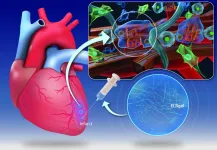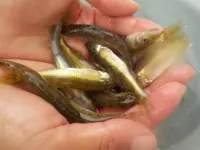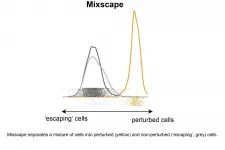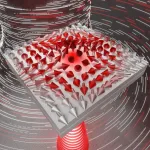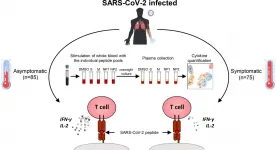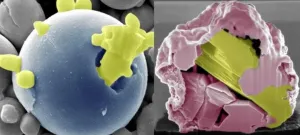(Press-News.org) Researchers at CÚRAM, the SFI Research Centre for Medical Devices based at National University of Ireland Galway, and BIOFORGE Lab, at the University of Valladolid in Spain, have developed an injectable hydrogel that could help repair and prevent further damage to the heart muscle after a heart attack.
The results of their research have just been published in the prestigious journal Science Translational Medicine.
Myocardial infarction or heart disease is a leading cause of death due to the irreversible damage caused to the heart muscle (cardiac tissue) during a heart attack. The regeneration of cardiac tissue is minimal so that the damage caused cannot be repaired by itself. Current treatments lack an effective method to prevent death and subsequent cardiac tissue repair following a heart attack.
"This project involved the development and testing of an elastin-based hydrogel derived from a naturally occurring biomaterial in the human body", explains Professor Abhay Pandit, Scientific Director of CÚRAM at National University of Ireland Galway and project lead. The hydrogel is based on a family of unique biomaterials, called elastin-like recombinamers, that BIOFORGE-UVa had developed in the search for advanced hydrogels for regenerative medicine. "The hydrogel was developed to mimic the environment around the heart following an infarction and then customised to have the ability to protect and promote regeneration of the cardiac tissue", says Professor Pandit.
The therapeutic effect of multiple injections of this hydrogel into the cardiac tissue was assessed during the first-ever preclinical study of its kind, demonstrating its efficacy for cardiac tissue remodelling following a heart attack.
The international research team, which included researchers from Ireland, Spain, Sweden, France and Italy, were able to show that if their hydrogel was injected into the heart muscle shortly after a heart attack, it resulted in less fibrosis (scarring of the cardiac tissue) and an increase in the generation of new blood vessels in the area. They were also able to observe the rise in the preservation and survival of cardiomyocytes, a type of cell that allows the heart to beat, in the affected area.
Professor Abhay Pandit added: "This project demonstrates the efficacy of a unique biomaterial-only system able to induce a positive healing effect on cardiac tissue following a heart attack event. The functional benefits obtained by the timely injection of the hydrogel supports and highlights the potential use of this treatment in the clinic. The next step will be to develop a prototype for a delivery system for the hydrogel."
Professor Mark Da Costa, Cardiothoracic Surgeon and senior co-author of the study, said: "In this study, we employed a model to specifically look at a type of heart attack that has increased in incidence and is not often treated until the acute phase resolves. Scar tissue that forms after the heart attack often remodels negatively, causing future problems like heart failure. The timely injection of this hydrogel appears to change the way the heart muscle heals after a heart attack. There is a significant positive histological, biological and functional recovery of the injured heart muscle. Work is progressing now to deliver this to the sites of injury in different clinical settings and will be followed with translation into a clinical trial."
INFORMATION:
The full research team also involved John Newell, Michelle Kilcoyne, Peter Owens and Peter Dockery from NUI Galway, CÚRAM PhD graduate Paolo Contessotto, Doriana Orbani? and José C. Rodríguez-Cabello from the BIOFORGE Lab at the University of Valladolid in Spain, Chunsheng Jin and Niclas G. Karlsson from the University of Gothenburg, Sweden, Sandrine Chantepie and Dulce Papy-Garcia from the Laboratory Cell Growth, Tissue Repair and Regeneration at the University Paris Est, Créteil, France, and Clizia Chinello and Fulvio Magni from the University of Milano-Bicocca, Vedano al Lambro, Italy.
CÚRAM's research focuses on developing diagnostic devices, biomedical implants, cell-device and drug-device combination products to address unmet clinical needs. The recent announcement of a €46 million reinvestment in CÚRAM by Science Foundation Ireland in February 2021, demonstrates the Government's strong commitment to the MedTech industry in Ireland, supporting the continuation of substantial academic, industry and clinical collaborations that are central to CÚRAM's work.
To access the full paper, visit https://stm.sciencemag.org/content/13/581/eaaz5380.
-Ends-
For Press contact Gwen O'Sullivan, Press and Information Executive, NUI Galway at gwen.osullivan@nuigalway.ie or +353 87 6601592.
Because walleyes are a cool-water fish species with a limited temperature tolerance, biologists expected them to act like the proverbial "canary in a coal mine" that would begin to suffer and signal when lakes influenced by climate change start to warm. But in a new study, a team of researchers discovered that it is not that simple.
"After analyzing walleye early-life growth rates in many lakes in the upper Midwest over the last three decades, we determined that water clarity affects how growth rates of walleyes change as lakes start to warm," said Tyler Wagner, Penn State adjunct professor of fisheries ecology. ...
The Earth's surface is subject to continual changes that dynamically shape natural landscapes. Global phenomena like climate change play a role, as do short-term, local events of natural or human origin. The 3D Geospatial Data Processing (3DGeo) research group of Heidelberg University has developed a new analysis method to help improve our understanding of processes shaping the Earth's surface like those observed in coastal or high-mountain landscapes. Unlike conventional methods that usually compare two snapshots of the topography, the Heidelberg approach can determine - fully automatically and over long periods - when and where surface alterations occur and which type of associated changes they represent.
The method, known ...
A team of researchers from New York University and the New York Genome Center has developed a new computational tool to help understand the function and regulation of human genes. The results, published today in the journal Nature Genetics, demonstrate how to interpret experiments that combine the use of CRISPR to perturb genes along with multimodal single-cell sequencing technologies.
The article describes how the new approach, called mixscape, helped to identify a new molecular mechanism for the regulation of immune checkpoint proteins that govern the immune system's ability to identify and destroy cancer cells.
"Our approach will help scientists to connect ...
The scientists have demonstrated how to structure light such that its polarization behaves like a collective of spins in a ferromagnet forming half-skyrmion (also known as merons). To achieve this the light was trapped in a thin liquid crystal layer between two nearly perfect mirrors. Skyrmions in general are found, e.g., as elementary excitations of magnetization in a two-dimensional ferromagnet but do not naturally appear in electromagnetic (light) fields.
One of the key concepts in physics, and science overall is the notion of a "field" which can describe the spatial distribution ...
A joint research team co-led by City University of Hong Kong (CityU) has developed a new soft tactile sensor with skin-comparable characteristics. A robotic gripper with the sensor mounted at the fingertip could accomplish challenging tasks such as stably grasping fragile objects and threading a needle. Their research provided new insight into tactile sensor design and could contribute to various applications in the robotics field, such as smart prosthetics and human-robot interaction.
Dr Shen Yajing, Associate Professor at CityU's Department of Biomedical Engineering ...
By analyzing blood samples from individuals infected with SARS-CoV-2, researchers in Singapore have begun to unpack the different responses by the body's T cells that determine whether or not an individual develops COVID-19. The study, published today in the Journal of Experimental Medicine (JEM), suggests that clearing the virus without developing symptoms requires T cells to mount an efficient immune response that produces a careful balance of pro- and anti-inflammatory molecules.
Many people infected with the SARS-CoV-2 virus do not develop any symptoms, and the infection ...
UNIVERSITY PARK, Pa. -- The rate of suicide among post-9/11 military veterans has been rising for nearly a decade. While there are a number of factors associated with suicide, veterans have unique experiences that may contribute to them thinking about killing themselves.
"Compared to their civilian peers, veterans are more likely to report having experienced traumatic adverse childhood experiences (ACEs) such as physical and emotional abuse," stated Keith Aronson, associate director of the Clearinghouse for Military Family Readiness at Penn State and the Social Science Research Institute ...
LAWRENCE -- A new study from University of Kansas journalism & mass communication researchers examines what influences people to be susceptible to false information about health and argues big tech companies have a responsibility to help prevent the spread of misleading and dangerous information.
Researchers shared a fake news story with more than 750 participants that claimed a deficiency of vitamin B17 could cause cancer. Researchers then measured if how the article was presented -- including author credentials, writing style and whether the article was labeled as "suspicious" or "unverified" -- affected how participants perceived its credibility and whether they would adhere to the article's recommendations or share it on social media. The findings showed that ...
AMES, Iowa - Inspired by nature's work to build spiky structures in caves, engineers at Iowa State University have developed technology capable of recovering pure and precious metals from the alloys in our old phones and other electrical waste.
Using controlled applications of oxygen and relatively low temperatures, the engineers say they can dealloy a metal by slowly moving the most reactive components to the surface where they form stalagmite-like spikes of metal oxides.
That leaves the least-reactive components in a purified, liquid core surrounded by brittle metal-oxide spikes "to create a so-called 'ship-in-a-bottle structure,'" said Martin Thuo, the leader of the research project and an associate professor of materials science and ...
A type of ultrasound scan can detect cancer tissue left behind after a brain tumour is removed more sensitively than surgeons, and could improve the outcome from operations, a new study suggests.
The new ultrasound technique, called shear wave elastography, could be used during brain surgery to detect residual cancerous tissue, allowing surgeons to remove as much as possible.
Researchers believe that the new type of scan, which is much faster to carry out and more affordable than 'gold standard' MRI scans, has the potential to reduce a patient's risk of relapse by cutting the chances that a tumour will grow ...
